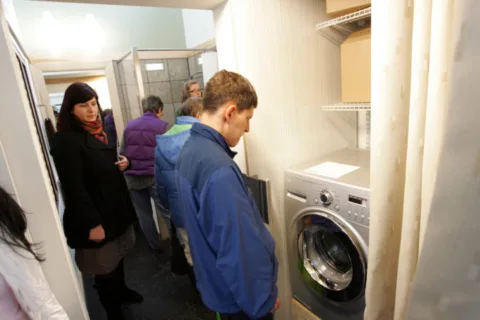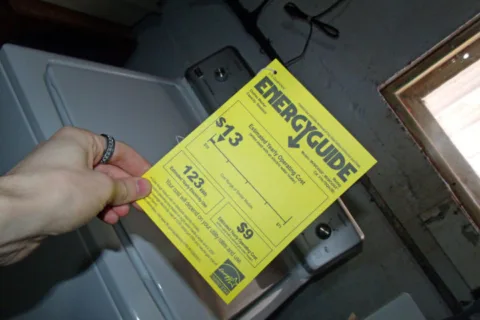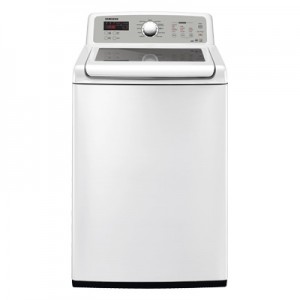If you follow my blog, then you already know that our ultra-expensive Kenmore Elite HE3t washing machine that we’ve had for 6 years turned out to be a piece of crap.
We kind of loved it at first (earth-shattering vibrations, notwithstanding) because it saved a lot of water and was very energy efficient in comparison to our previous washer, a Whirlpool top-loader. It also did a good job of cleaning our clothes.

After reading in various appliance repair forums and comparing symptoms of our washer with topics in the forums (see Sounds Like Rocks Are In The Washer When It Spins The Clothes, as an example), I learned that the bearings were shot and it would lead to a very expensive repair bill.
In my opinion, it was time to move on and put that money to better use by looking at some newer energy efficient washers.
Yes, it was was Energy Star qualified, but the Kenmore HE3t was not engineered very well for the long term.
Not only that… I was ready to look at newer technologies that would reduce, or eliminate, the horribly violent vibrations that the front-loader was putting out on a regular basis. There is an inherent design flaw with the HE3T that we owned, and anyone who puts the HE3T washer on anything other than a cement slab has similar problems.
Read my article about all the problems of the Kenmore HE3T washing machine, and similar models.
My solution to our dilemma was not to spend $400 to $600 on repairs when that same amount of money would buy a brand new SEHA-rated (Super-Efficient Home Appliance Initiative) washer that will clean our clothes quieter and more efficiently than the Kenmore HE (model 110.459764) did.
Energy Efficiency Ratings For Washing Machines
Buying a washer is not an easy process for someone like myself. I will research it to death before pulling out my wallet, when it comes to major purchases.
Besides the obvious washing machines’ capabilities to actually clean the clothes as a top consideration, one of the criteria for washers that I learned about was CEE Tier ratings. That’s right, not only are there Energy Star ratings for washers, there are also CEE Tier ratings for home appliances to consider.
Okay, so there are federal standards, Energy Star standards, and CEE Tier ratings. Guess which set of standards are the bare minimum that a manufacturer can get away with and still put their product on the market in the U.S.. You guessed it… federal standards.
Energy Star ratings are important but little-known CEE Tier ratings will make the most difference in increasing energy and water efficiency technologies for appliances in the marketplace simply because they are more strict.
So, if you want your voice as a consumer to be heard by appliance manufacturers, insist on purchasing appliances based on the CEE 3-Tier system. Tier 3 is the most stringent of the three.
CEE vs Energy Star vs Federal Standards
CEE is an EPA Climate Protection award-winning consortium of efficiency program administrators from the United States and Canada. Members work to unify program approaches across jurisdictions to increase the success of efficiency in markets. By joining forces at CEE, individual electric and gas efficiency programs are able to partner not only with each other, but also with other industries, trade associations, and government agencies. Working together, administrators leverage the effect of their ratepayer funding, exchange information on successful practices, and, by doing so, achieve greater energy efficiency for the public good. — CEE
Tiers for washers are based on 2 factors: MEF and WF:
- MEF = Modified Energy Factor, a combination of Energy Factor and Remaining Moisture Content. MEF measures energy consumption of the total laundry cycle (washing and drying). It indicates how many cubic feet of laundry can be washed and dried with one kWh of electricity; the higher the number, the greater the efficiency.
- WF = Water Factor (number of gallons needed for each cubic foot of laundry). A lower number indicates lower consumption and more efficient use of water.
Here is the breakdown of the different standards on the marketplace today:
- The Federal Standard for MEF is 1.26 and WF is 9.5.
- The Energy Star standard for MEF is 2.00 and WF is 6.0.
- CEE Tier 1 standard for MEF is 2.00 and WF is 6.0.
- CEE Tier 2 standard for MEF is 2.20 and WF is 4.5.
- CEE Tier 3 standard for MEF is 2.40 and WF is 4.0.
See, at a glance, how Energy Star and CEE Tier ratings overlap.
Be sure to look for that information on the appliances that you’re shopping for. If it’s not in plain sight, ask the salesperson for details.
Rest assured that all high-efficiency washers — top load and front load — are Energy Star-qualified.
You may have to look a lot closer at the literature for the models that you are considering in order to locate the CEE Tier ratings.
The Energy-Efficient Washer We Chose
 The washer we picked out (Samsung WA5451ANW) is a Tier 3 unit.
The washer we picked out (Samsung WA5451ANW) is a Tier 3 unit.
It was one of the few — if not the only — washing machine that had absolutely no negative online reviews (performance-wise) at the time that we looked.
The same could not be said for top-rated Maytag Bravos washer models that we were seriously considering. The new Maytags have a tendency to twist clothes so bad during the wash cycle that wrinkles were extremely difficult to remove, if not impossible.
Samsung’s infuser (where the agitator used to be in older models) is a different type of technology from Maytag’s infuser.
Energy Star’s Clothes Washing Advice
The following helpful hints for washing clothes come from Energy Star:
- Always use HE detergent in HE washers.
- Fill up the washer to capacity each load. They use approximately the same amount of energy per load whether or not it is maxed out.
- Wash in cold water whenever possible. Heating water consumes approximately 90% of the energy required for a load.
- Avoid the sanitary cycle. It dramatically increases the energy required for a load of clothes due to the extremely hot water necessary to sanitize.
- Leave the door open when not in use to avoid any mold issues.
- Rinse the washer with 1 cup of bleach to reduce the buildup of mold and mildew.
Helpful Resources About Energy Efficient Washers
- CEE Clothes Washer Qualifying Product List
- Buying Energy Efficient Washers: What To Look For
- Choosing A Washing Machine: Top-Loading vs. Front-Loading
- Consumer Reports’ Recommended Washing Machines
- How Long Will It Take An Energy Efficient Washer To Pay For Itself?
- CNET’s Washing Machine Buying Guide



